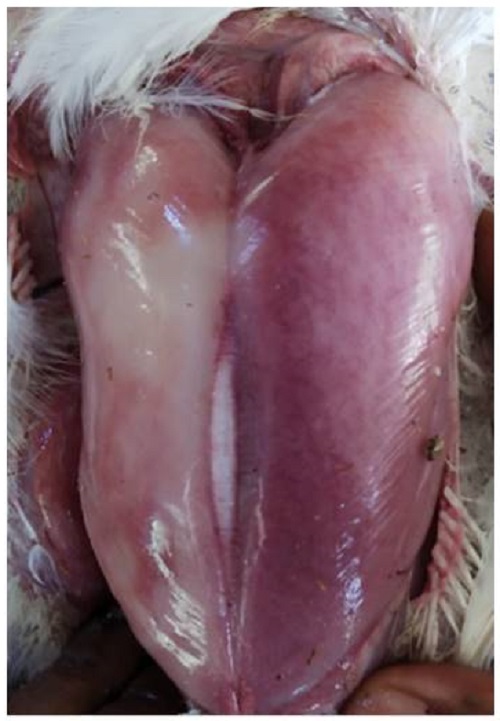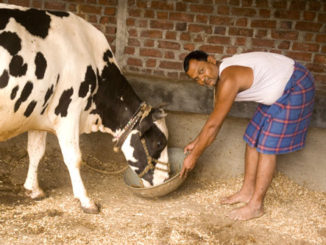Sometimes there may not be much time to go for details diagnostic approach when we experienced 20 per cent mortality of broiler birds of 26 days in a farm reared by a farmer of Port Blair, Andaman and Nicobar Islands, India. Due to geographical isolation from the mainland of India, there is lack of infrastructural facility for thorough laboratory diagnosis. But based on post mortem finding and history of treatment, an unconventional treatment produced havoc to reduce the mortality to zero per cent which prompted us to confirm the diagnosis as toxicosis/mycotoxicosis associated with feed. A farmer who rears average 500 birds faced 20 per cent mortality over a period of 12 days. Although the farmer tried firstly for 5 days with Cephalexin oral powder in therapeutic doses, followed by amprolium at therapeutic dose for 3 days and lastly before approaching for treatment to us he continued treatment with tiamulin hydrogen fumarate. Even if after these interventions, average daily mortality ranged between 10-12 days.
After inspection of the farm, this was found by us, the birds are reared in deep litter system and farm is managed maintaining proper hygienic measure. On the first day of visit, this was found that, 5 % birds had abnormal yellow droppings, general inactivity, closed eye and drooped wings. On the spot necropsy of ten dead birds were done. Post mortem finding of all birds revealed that, there was congestion of the breast muscle (Fig.1), swollen kidney (Fig.2) and enlargement of liver. Apart from these changes no other pathognomonic lesions were found.


Based on the post mortem finding and ineffectiveness of antibacterial, anticoccidial and anti-mycoplasma compounds, as a clinician we suspected the cause of death as non-infectious origin. The farmer was advised the following treatment/suggestion:
- Withdrawal of existing feed and feeding of crushed maize with incorporation of 0.5 g copper sulphate per kg of feed.
- Sugarcane molasses @ 10g per litre of water continuously for five days
- Curd @ 10g per litre of water once daily for five days
- Protinex, a commercial health drink powder was added @ 10 g per litre of water twice daily as a source of energy, carbohydrate, protein, iron, calcium, phosphorus and sugar.
This was found that, 24 h after treatment the mortality reduced to zero, which prompted us to come to the conclusion that, toxicosis was of feed origin and this treatment regime is of high value since the same has reduced the mortality. We therefore, hypothesize that, copper sulphate introduction has antimycotic effect, sugar cane molasses has flushed the toxin from the gut and a readymade source of vitamin H, Curd might have increased the gut immunity and more essentially worked as toxin binder and Protinex has dietary support to overcome the shortcomings of maize supplementation. We conclude that, this combination has created havoc to treat toxicosis/mycotoxicosis of feed origin. Because frequent rain in these islands may be predisposing cause of development of mycotoxin in the feed and as general practice toxin binders are not used in the feed.
| The content of the articles are accurate and true to the best of the author’s knowledge. It is not meant to substitute for diagnosis, prognosis, treatment, prescription, or formal and individualized advice from a veterinary medical professional. Animals exhibiting signs and symptoms of distress should be seen by a veterinarian immediately. |
How useful was this post?
Click on a star to review this post!
Average Rating 4.9 ⭐ (60 Review)
No review so far! Be the first to review this post.
We are sorry that this post was not useful for you !
Let us improve this post !
Tell us how we can improve this post?
Authors
-

Scientist, Division of Animal Science, ICAR-Central Island Agricultural Research Institute, Port Blair, Andaman and Nicobar Islands
-

Scientist, Division of Animal Science, ICAR-Central Island Agricultural Research Institute, Port Blair, Andaman and Nicobar Islands
-

Senior Scientist, Animal Science Division, ICAR-Central Island Agricultural Research Institute, Port Blair, Andaman and Nicobar Islands, India
-

Principal Scientist, Division of Animal Science, ICAR-Central Island Agricultural Research Institute, Port Blair, Andaman and Nicobar Islands
-

Principal Scientist, Animal Science Division, ICAR-Central Island Agricultural Research Institute, Port Blair, Andaman and Nicobar Islands, India
-

Senior Scientist, Animal Science Division, ICAR-Central Island Agricultural Research Institute, Port Blair, Andaman and Nicobar Islands, India





Be the first to comment